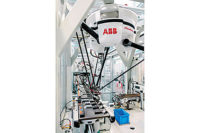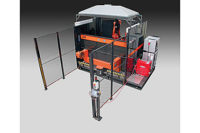Wood + Water = Speed
The Roaring Twenties fueled a huge demand for speed in America. Daredevils such as Malcolm Campbell raised the land speed record to more than 200 mph. In the air, barnstormers such as Jimmy Doolittle continually pushed the envelope. For instance, between 1920 and 1924, the absolute world air speed record was broken 15 timesrial, rising from 171 mph to 278 mph.
Record attempts on land, sea and air were widely publicized in the news media, and the speed kings were toasted from coast to coast. The thrill of speed spilled over to recreational boating on the nation’s lakes and rivers.
New technology and mass-marketing helped spur demand for a new type of watercraft called a "speedboat" or a "runabout." These wooden boats featured open cockpits, powerful engines and long, sleek hulls that cut through water. By 1926, more than 200,000 pleasure boats were registered in the United States.
Many boatbuilders adopted assembly techniques from the auto industry to keep up with consumer demand. Three Michigan companies dominated the golden age of mass-produced wood speedboats in the 1920s and 1930s: Chris-Craft, Dodge and Gar Wood.
Chris Smith & Sons Boat Co. manufactured its Chris-Craft line at a 114,517-square-foot plant in Algonac, MI. Smith pioneered mass production methods, such as in-line production, in the mid-1920s. By 1929, the company was generating more than $3 million in sales. It produced 18 different models in four basic hull lengths—ranging from 22 to 30 feet—on four separate assembly lines.
Horace E. Dodge and Co. Boat Works operated a 75,000-square-foot plant in Detroit. In 1925, the company headed by the heir to the Dodge automobile fortune claimed to be building five Watercars a day. In 1930, Dodge opened a 210,000-square-foot assembly plant in Newport News, VA, and boasted that it was "the largest boatbuilding facility in existence." Unfortunately, the plant was forced to close in 1936 because of the Great Depression.
Gar Wood Inc. maintained a 63,000-square-foot plant in Marysville, MI, that could assemble 1,200 boats a year. Garfield Wood invented the hydraulic lift in 1911 and made a fortune manufacturing hoisting devices. The industrialist turned his hobby of speedboat racing—he was famous for winning match races against express trains such as the Twentieth Century Limited—into a business by producing a popular line of Baby Gar boats.
Wood used innovative production tools in his plant, such as electric drills and screwdrivers, to boost efficiency. The facility featured an overhead monorail system for moving hulls from station to station; concrete wells in the factory floor to facilitate deck installation without the need for ramps or scaffolding; and a special ventilation system that controlled humidity and temperature and created a dust-free environment for varnishing and painting.
Assembly techniques varied among manufacturers, but large pieces of a boat’s frame, such as the transom and stem, were typically assembled from white oak. The rest of the boat, such as hull planks and decks, used Philippine mahogany.
Wood speedboat builders commonly used a double-planked bottom with floating intermediate frames fastened at intervals between sawn frames. The typical boat contained more than 4,000 fasteners. Copper rivets were used to fasten the frame and the first row of planking. The second row of planking was fastened with brass screws.
In-line manufacturing represented a radical change in the industry. Before the assembly line became popular, boat building was a process by which a crew of workers would build an entire boat, from laying the keel through framing, planking and finishing.
With the new production methods, standard keels, frames, stringers, rails, decking and other components were cut using precise templates so that each boat would be identical to the next. People with individual specialties worked on each boat at a regulated point in the assembly process. By using in-line production, Chris-Craft was able to boost production to four boats a day and supply the growing market for speedboats at lower prices than its competitors.
An article in the May 1926 issue of Motor Boating magazine described Chris Smith’s manufacturing facility as "one of the best examples of a boat factory that has established a reputation for inaugurating production methods never before attempted in the boating field.
"After a keel has been laid down, the sawed shapes are clamped to the keel and the side planking is in place. The boat is automatically lifted up and moved into the next position where the engine stringers are bolted into place and the chines are bolted to the sawed shapes.
"It is then turned over, again bottom up, and the first layer of planking is laid on diagonally. The heavily oil-soaked mahogany used in the first layer is first varnished and then canvassed.
"The next process is the laying of the fore and aft planking, which is screw fastened to the sawed shapes. The ribs are then fastened into the bottom and screwed to the double planking of the bottom from the inside. The sides are then bunged and plugged with mahogany plugs to cover up the screw heads.
"From this junction, the hull is moved along the production line where the sides and bottom are planed, scraped and sanded, after which a heavy coat of green bottom paint is applied. The sides are now ready for the mahogany filler, which is applied and rubbed. Then the inside is given a heavy coat of hot oil below the water line and two coats of Valspar over the entire inside with a top coat of battleship gray paint.
"Gangs of workmen furnished with all their needs rapidly prepare the boat with engine room and fore peak flooring and the next operation is to strike or mark the shear and trim it. Whereupon another crew then come on the boat, installing the deck carlins, hatch headers and cockpit trimmers, followed by the fastening on of the covering boards and the laying of the deck. Next, fastenings are bunged, decks are planed, scraped and sanded. A painting crew take charge of the boat and a mahogany filler is applied to the decks.
"The next wave of production includes the joinery operations, which really complete the runabout, making it ready for the finishing room. In this process, the skilled joiners install the combing, engine room, hatch frames and hatches. Then comes the flooring of the forward and after cockpits, accompanied by the installation of the engine room bulkheads. The seat frames are now ready to be set up, together with the side cockpit paneling.
"The cowl and instrument board are now installed at this point and the windshield mountings are put in place. The runabout is ready to be checked and inspected for the scratches and blemishes, which might have occurred during these operations. These are carefully removed before the final mahogany filling is applied and the boat is ready to enter the finishing room. Four coats of varnish are applied in succession to both the hull and the finished mahogany wood work and trim.
"The upholstery is made in a separate building where it is put on the boat together with engine snaps and all the nickel hardware and fender streaks. The boat is now ready for the final operation, which is the motor installation.
"A crew of expert mechanics install the motor, fastening it rapidly into place. The gasoline tanks are connected up, the shaft is lined up and the steering gear, instrument board and engine controls are put into place. The boat is now ready for launching and testing."
Chris Craft operated a manufacturing complex that consisted of more than 20 separate buildings devoted to particular tasks, such as a machine shop, a woodworking mill, an upholstering department and three assembly buildings. In contrast, Dodge and Gar Wood consolidated all operations under one roof to improve efficiency. In fact, Gar Wood boasted that it operated "the world’s most efficient boat plant."
Many wood speedboat builders went out of business in the 1950s because of escalating production costs. New materials and production methods that were developed during World War II transformed the industry. For instance, aluminum, fiberglass and plywood were used to construct hulls, while epoxy, Thiokol sealant and welding were used for joining applications. In addition, new types of boats, such as cabin cruisers, became more popular.
Speedboat builders began to embrace fiberglass in the mid-1950s because it allowed greater design flexibility and lower production costs. The first fiberglass Chris-Craft boat debuted in 1957 and the company manufactured its last all-wood boat in 1972.
Chris-Craft is the only brand name that survives from the golden age of speedboats. However, it has gone through several different owners since the Craft family sold its interest in 1960. The company currently is under new management and is mass-producing a line of all-fiberglass boats at a plant in Sarasota, FL. A handful of small companies still produce speedboats with wood hulls and decks, but they are custom-built.
Looking for a reprint of this article?
From high-res PDFs to custom plaques, order your copy today!





